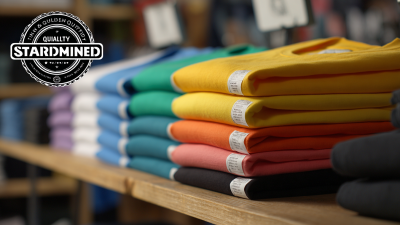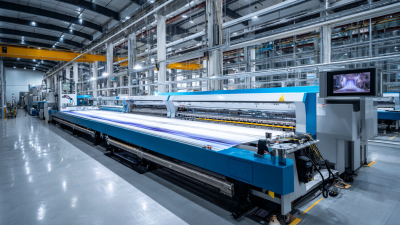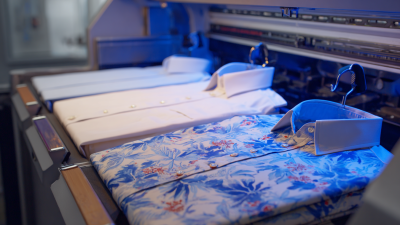As we anticipate the 2025 China Import and Export Fair, the spotlight is firmly on the emerging market trends for Machine Print Shirts, a segment that has seen remarkable growth in recent years. According to a report by Grand View Research, the global custom t-shirt printing market is projected to reach USD 3.64 billion by 2025, driven by the increasing demand for personalized apparel and advancements in printing technology. The Fair, being one of the largest trade events in Asia, offers an unprecedented platform for manufacturers and distributors to showcase innovative designs and printing techniques. Furthermore, a study by MarketWatch indicates a growing consumer preference for unique and custom designs, which is expected to further fuel the Machine Print Shirts market. As we explore these trends at the Fair, it is essential to understand the factors shaping the industry and the potential opportunities for growth in this dynamic sector.

The 2025 China Import and Export Fair, commonly known as Canton Fair, serves as a vital platform for showcasing machine print shirts, reflecting the dynamic trends within the apparel industry. With China's rapid evolution into a leading innovator in advanced manufacturing techniques, the market for machine print shirts is poised for significant growth. The advancements in technology enable local manufacturers to produce high-quality apparel that meets global standards, attracting international buyers and suppliers eager to capitalize on the evolving fashion landscape.

As various trade fairs unveil the latest developments in manufacturing, the demand for machine print shirts is anticipated to rise. The Canton Fair, being one of the largest exhibitions worldwide, facilitates valuable connections between Chinese suppliers and global retailers. With such a robust marketplace, participants can explore a diverse range of products while gaining insight into market trends and consumer preferences. The fair not only showcases innovative designs but also highlights the potential for sustainable practices within an increasingly competitive sector.
As we approach the 2025 China Import and Export Fair, understanding the key consumer trends influencing machine print shirt sales becomes paramount. According to a report by Statista, the global custom t-shirt printing market is projected to reach USD 3.64 billion by 2025, with a compound annual growth rate (CAGR) of 9.7%. This growth is largely driven by consumers seeking personalized fashion options that reflect their individuality and values. Notably, millennials and Gen Z, who prioritize sustainability and ethical production, are increasingly favoring brands that align with their ideals.
Moreover, the rise of e-commerce continues to reshape how consumers engage with fashion. A study from Allied Market Research indicates that the online custom apparel market is anticipated to witness a substantial increase, with a CAGR of 10.8% from 2019 to 2026. This shift is empowering consumers to design their own machine print shirts, fostering a sense of ownership and connection to their clothing. Brands that leverage user-friendly online platforms and integrate social media marketing are likely to resonate with this trend, enhancing their market presence in a competitive landscape.
The machine print shirt market is witnessing dynamic changes driven by various competitive players who are reshaping industry standards and consumer preferences. Leading companies focus on enhancing product quality and design diversity, leveraging advanced technologies such as digital printing to achieve intricate patterns and customizable options. These capabilities are particularly appealing to younger consumers who prioritize individuality in their fashion choices.
Furthermore, the competitive landscape is marked by a growing emphasis on sustainable practices. Many key players are investing in eco-friendly materials and production methods to meet the increasing demand for sustainable clothing options. As awareness of environmental issues rises among consumers, brands that can demonstrate a commitment to sustainability are likely to gain a competitive edge. This trend reflects a broader shift within the fashion industry towards responsible sourcing and transparency, indicating that the machine print shirt market will continue to evolve in response to both consumer preferences and global challenges.
| Market Segment | Market Share (%) | Growth Rate (CAGR %) | Key Trends |
|---|---|---|---|
| Casual Wear | 35 | 5.2 | Sustainability, Customization |
| Formal Wear | 25 | 4.8 | Tech Integration, Smart Fabrics |
| Sportswear | 20 | 6.0 | Active Lifestyle, Breathable Fabrics |
| Kids Wear | 10 | 5.5 | Bright Colors, Cartoon Patterns |
| Others | 10 | 4.0 | Niche Markets, Vintage Styles |
At the 2025 China Import and Export Fair, the spotlight on machine print shirts highlights not just market trends but also the innovative technologies that are revolutionizing their manufacturing. One of the key advancements driving this change is digital printing technology, which allows for precise and vibrant designs that cater to diverse consumer preferences. This method significantly reduces waste compared to traditional printing techniques, aligning with the growing demand for sustainable fashion practices. As manufacturers increasingly adopt these technologies, they can offer more customized products, responding quickly to evolving market demands.
Another noteworthy innovation shaping the landscape of machine print shirt production is the use of automation and artificial intelligence. These technologies streamline the production process, enhance efficiency, and ensure consistent quality across large volumes of output. AI-driven analytics can optimize inventory management and predict trends, enabling manufacturers to stay ahead in the competitive market. By integrating these sophisticated technologies, companies not only improve their operational capabilities but also elevate the artistry and personalization of their machine print shirts, positioning themselves effectively in a fast-evolving fashion industry.

The increasing awareness of sustainability and eco-friendly practices is reshaping the landscape of the fashion industry, particularly in the production of machine print shirts. As we approach the 2025 China Import and Export Fair, manufacturers are now prioritizing environmentally conscious methods that minimize waste, reduce carbon footprints, and utilize sustainable materials. This shift is critical, especially considering the fashion industry is one of the significant contributors to global pollution and carbon emissions.
Tips for sustainable shirt production include opting for organic or recycled fabrics, which significantly lessen environmental impact. Additionally, integrating lean manufacturing techniques can help reduce waste throughout the production process. Engaging in transparency by sharing these sustainable practices with consumers can also foster trust and loyalty toward the brand, appealing to an increasingly eco-aware consumer base.
As the market trends evolve, the demand for machine print shirts made sustainably will likely surge. Brands that prioritize eco-friendly practices not only contribute positively to the environment but also align themselves with the growing consumer expectation for responsible fashion choices. Emphasizing these sustainable methods will be crucial for success at upcoming trade fairs and beyond, as businesses strive to adapt to this changing landscape.






